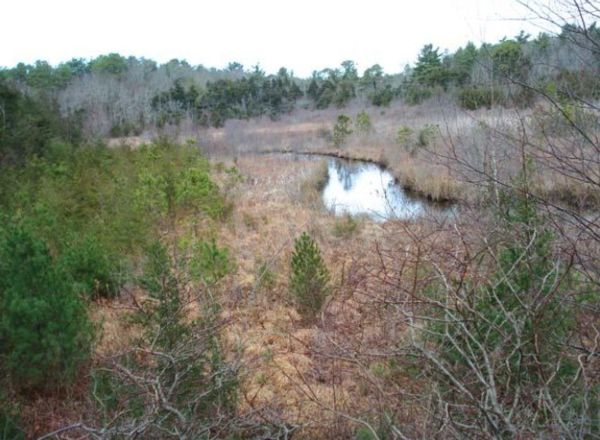Blog / Get to Know Cape Cod / The Skunknett River Wildlife Sanctuary in Osterville, Massachusetts
Osterville is a small village in Barnstable that is bordered by Cotuit, Centerville, and Nantucket Sound. The village's waterfront location makes it popular with seasonal residents, and there are plenty of beaches to explore in the summer.
There's more to Osterville, Massachusetts, than oceanside estates and busy beaches, however, as once you head into the northern part of the community, you'll reach ponds, woodlands, and nature.
One of the more visible examples of nature in Osterville is the Skunknett River Wildlife Sanctuary, a 147-acre reserve with kettle ponds, marshes, and all kinds of animal-viewing opportunities.

Photo taken from https://www.barnstablepatriot.com/article/20130411/news/304119978
When you buy a home in Osterville, you'll want a little escape from the busyness of the summer, and the Skunknett River Wildlife Sanctuary provides an area of refuge in one of Cape Cod's most scenic locations.
How to Get There
Reaching the Skunknett River Wildlife Sanctuary is relatively easy since it sits between Main Street and Massachusetts Route 28, a few blocks north of downtown Osterville.
When coming from Main Street in Osterville, head north on Old Mill Road and follow it until it intersects with Bumps River Road. Turn left on Bumps River Road and continue until you see a Mass Audubon sign, which will direct you into the parking lot.
If you're arriving from elsewhere on the Cape, you can take the Mid-Cape Highway until you reach Exit 5. After your exit, you'll come to a fork, which you'll take to the left onto Osterville – West Barnstable Road. Follow that road until it forks with Lumber Mill Road, and then take Lumber Mill Road until it intersects with 5 Corners Road. Within seconds, 5 Corners Road becomes Bumps River Road, which you'll follow to the parking lot.
The Hiking Trails
As you reach the parking lot, you'll immediately find yourself surrounded by trees. Depending on your chosen route, you might have already seen the pond along the side of the road, too.
The first section of the hiking trail, called Bog Cart Path, isn't very long, as it quickly cuts through the woods to West Pond. Once you reach the pond, you'll get onto the West Pond Circuit Trail, which is the main path through the area.
Quickly after reaching the main trail, you'll see that there's a cutout that leads to another path, which is called Overlook Trail. Overlook Trail is the highlight of the journey because it provides panoramic views of West Pond. From here, you can see all kinds of birds and other wildlife.
Heading north from Outlook Trail, you'll soon reach North Swamp Trail, which leads to North Swamp. This marshland is another excellent place for birdwatching and well worth checking out.
After North Swamp Trail, you'll get back on the main trail until you reach Fox Hollow Trail. This path leads north to Fox Hollow Lane, which is a residential street just off Route 28. The Atlantic White Cedar Stand, which is home to a cluster of this increasingly rare tree, is near the entrance to Fox Hollow Path, as well.
After passing the Atlantic White Cedar Stand, you'll continue on the West Pond Circuit Trail and have the option of taking another detour onto Holly Trail. This path is narrow and leads to a vernal pool, which is a temporary pond that acts as a breeding site for reptiles and amphibians. You're sure to hear some wood frogs if you visit in March or April.
Finally, you can continue on the West Pond Circuit Trail until it meets back up with Bog Cart Path and takes you back to your vehicle.
Wildlife in the Area
Since all trails venture through wetlands and near ponds, you'll very likely encounter some wildlife on your travels.
Many people who visit the Skunknett River Wildlife Sanctuary do so in search of rare birds, including the black-crowned night herons and ospreys that often nest in the area. There are also migrating ducks at certain times of the year.
If you get close enough to the waterways, you might even see some American eels, as the name Skunknett comes from an Algonquin word meaning "a fishing place for eel."
No matter what, you're sure to see and hear some wildlife during your time in the sanctuary.
On-site Historic Attractions
As you might expect in such a diverse wetland, there's some history through the Skunknett River Wildlife Sanctuary that remains visible to this day.
When you first embark on Bog Cart Path, there's an old cranberry bog on the left-hand side. The swamp is no longer in use but acts as a reminder of the area's past.
There are also the three historic mill sites near the park's waterways. The owners abandoned these mills long ago, and nature is slowly reclaiming them, which is an interesting scene to behold.
Donations are Appreciated
Admission to the Skunknett River Wildlife Sanctuary is free, although there is a donation box at the park entrance, and Mass Audubon welcomes anything you can contribute.
You can also donate to Mass Audubon online, as the money they raise is used to keep this and other wildlife sanctuaries throughout the state open and thriving.
When you live in Osterville, you'll find plenty of ways to spend your days. Still, the Skunknett River Wildlife Sanctuary might just become one of your favorites because of its quiet atmosphere, leisurely paths, and outstanding wildlife-viewing opportunities.